History
The Santo Stefano Complex, dedicated to Saint Stephen, the
first Christian martyr,
is also known as the Seven
Churches (Sette Chiese). Legend says it was built on the site of
a Roman temple and spring dedicated to the Egyptian goddess Isis around 430 by
Saint Petronius who, following a pilgrimage in the Holy Land, founded the seven churches here
symbolising the seven stations Jesus stopped at on his climb. The first written evidence,
however, dates to 887, under Charles the Fat.
From the the piazza in front you can see three churches
(see photo right).
On the left is Santi
Vitale e Agricola, the oldest church in Bologna, then San Sepolcro in the
centre, behind the tree, and
finally the Crocifisso, the
last and
largest, with a 13th-century pulpit on its fašade, now inaccessible due to
the demolition of of an internal gallery. The Crocifisso's doorway serves as the
entrance to the complex, except when there's a service taking place
inside.
To the right, past the trees, is the later Celestine Benedictine
convent, established here in 1493 by Pope Julius II. The monks fell victim
to the Napoleonic suppression of 1797. Attempts to lure monks back were
unsuccessful, until the Olivetans moved in in 1941, and they remain here.
The churches
The Crocifisso (see
right) (previously known as the church of San Giovanni Battista) is
probably of Lombard (8th century) foundation with rebuilding in the 12th. Restoration in the past
century has attempted to return the church to its medieval appearance.
There is a painted Crucifix by Simone dei Crocifissi (c. 1380)
hanging in the arch to the presbytery for which the church is named. The
frescoed altarpiece is a 14th-century Crucifixion described as
'school of Giovanni da Modena.' The life-size PietÓ group
against the left wall is 18th-century and by Angelo Pi˛.
There are some 16th- and 17th-century panels.
The
crypt under the very raised presbytery was built
in 1019 to house the relics of Vitale and Agricola (in an urn on the
altar) and was originally
entered from the Cortile di Pilato. The salvaged columns include one, the
second from the entrance on the right, without a capital, that Petronius is said
to have brought from the Holy Land and which is the same height as Jesus.
There is the statutory Lippo di Dalmasio detached fresco fragment of the
Virgin and Child down here too.
To the left of the steps down to the crypt is the door to
Santo Sepolcro (see right).
May be as old as the 5th century,
and possibly once the site of a Roman temple dedicated to Isis, which was built over
a handy spring. The circle of columns are said to come from this
original temple. Its present form is 11th century. Centrally-planned
dodecagon with an
ambulatory and women's galleries. The structure in the
centre is a 12th-14th-century copy of the Holy Sepulchre at Jerusalem. It is
now embellished with a Romanesque pulpit with deep-sculpted reliefs of the
attributes of the Four Evangelists. On the main structure three carved
panels depicting the Three Marys at the Tomb. The stairs and altar
are 19th century.
Behind a grill is the tomb of Saint Petronius, Bolognaĺs
patron saint. His remains, discovered in 1141, were kept here but were
later, in
2000, transferred to San Petronio in Piazza Maggiore, which already had his head.
The door opposite the one from the
Crocifisso leads into
the ancient and atmospheric
Santi Vitale e Agricola
(see right). Dedicated to two local saints,
martyred in 304, it's bare and
Romanesque and maybe 5th century,
but likely built in the 11th century over a church dedicated to Saint
Peter. In the 15th century a rumour spread that Saint Peter was buried
here and the then pope, angry at St Peter's in Rome being put in the
shade, had this church filled with earth. Massive brick column clusters alternate with stone columns,
many bound in iron, and
an eclectic mix of capitals - cushion, Byzantine and Ionic - many from Roman
buildings. The apse and flanking apsidal chapels have slim alabaster windows. The altars in the apsidal chapels are 8th- or
9th-century and were sarcophagi containing the relics of Saints Vitalis
(left) and Agricola
(right) who were martyred in Bologna under the emperor Diocletian. These remains
were discovered in a Jewish cemetery and dug up in 392 by Saint Ambrose and where
later translated to
the crypt in The Crocifisso church here on March 3rd 1019 by Abbot Martino,
who was responsible for the building of said crypt.
There's a detached fresco panel in the rear right bay of
The Virgin
and Saints.
Returning to
Santo Sepulcro, doors lead into the 12th-century
Cortile di Pilato, so named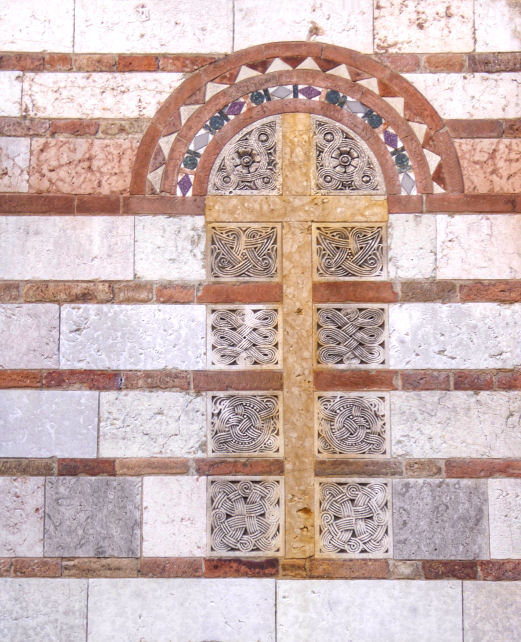 to
commemorate the place where Pontius Pilate tried Jesus. In the middle is a stoup
called Pilateĺs Bowl, which had the reputation being the bowl in which
Pilate washed his hands. From the 8th century, it has an obscure inscription relating to the
Lombard kings Luitprand and Ilprand, who are said to have donated it. Two small chapels and one large one with
a worn 14th century fresco open off the loggias down each side of the
courtyard, plus one that's closed. On a pillar
in a little window to the left of one chapel is a cockerel, sculpted in
the 14th century, representing the one which crowed twice to mark Peter's
denial of Christ. Opposite the rather special
patterned brickwork on the back wall of San Sepolcro is the fašade of
the wide and shallow Martyrium,
(also known as the Church of the Trinity).
Dating to the 13th century it may have been the east end of the 4th
century church, or the later Lombard one. It was rebuilt in 1911 and again
faced with lovely
patterned brickwork. This chapel, restored in 1924, has a line of columns
with good capitals down the centre and a fine old pavement and is believed
to have been originally built over a walled Christian cemetery. Also here
is a group of
five stout wooden statues of the Adoration of the Magi, in a
glass case, painted by the workshop of Simone dei
Crocifissi (c.1370) and a damaged stone statue of Saint Peter
seated. Plus
some sweet little detached fresco fragment panels. to
commemorate the place where Pontius Pilate tried Jesus. In the middle is a stoup
called Pilateĺs Bowl, which had the reputation being the bowl in which
Pilate washed his hands. From the 8th century, it has an obscure inscription relating to the
Lombard kings Luitprand and Ilprand, who are said to have donated it. Two small chapels and one large one with
a worn 14th century fresco open off the loggias down each side of the
courtyard, plus one that's closed. On a pillar
in a little window to the left of one chapel is a cockerel, sculpted in
the 14th century, representing the one which crowed twice to mark Peter's
denial of Christ. Opposite the rather special
patterned brickwork on the back wall of San Sepolcro is the fašade of
the wide and shallow Martyrium,
(also known as the Church of the Trinity).
Dating to the 13th century it may have been the east end of the 4th
century church, or the later Lombard one. It was rebuilt in 1911 and again
faced with lovely
patterned brickwork. This chapel, restored in 1924, has a line of columns
with good capitals down the centre and a fine old pavement and is believed
to have been originally built over a walled Christian cemetery. Also here
is a group of
five stout wooden statues of the Adoration of the Magi, in a
glass case, painted by the workshop of Simone dei
Crocifissi (c.1370) and a damaged stone statue of Saint Peter
seated. Plus
some sweet little detached fresco fragment panels.
Through the right hand door from the Martyrium is the
Benedictine
cloister, the lower part dating from the 11th century and the upper from
the 12th. It is said that Dante spent so much time sitting here that the
odd figures in the capitals inspired descriptions of the damned in The
Inferno. There's a good view of the Romanesque
campanile too. Occasionally the door along the colonnade opposite the
entrance to the shop will be open allowing access to the garden to the
south of the Crocifisso church, but
it's pretty uninteresting.
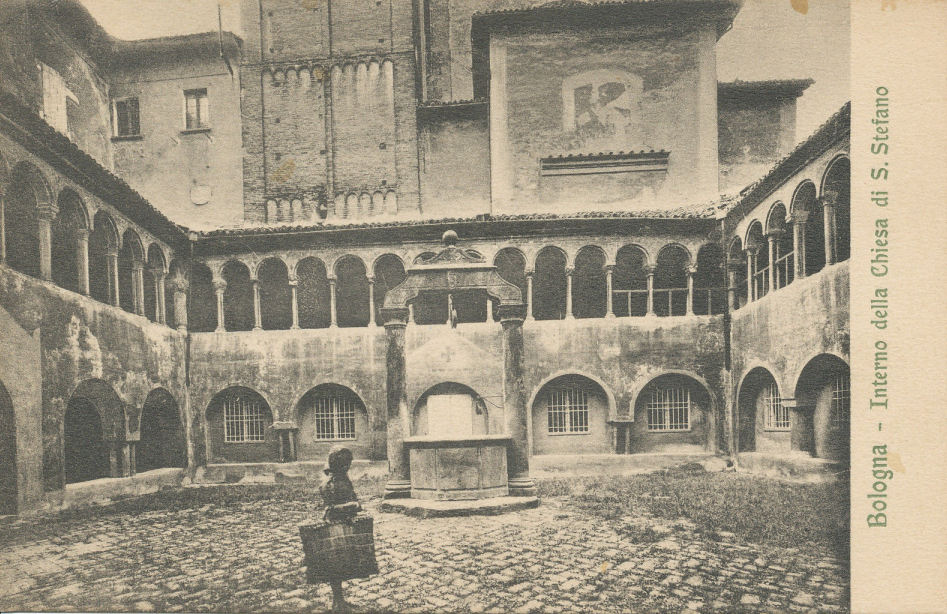
Off of this cloister is the shop and a small and dusty Museum
with five rooms and some nice panels and detached frescoes, as well as
reliquaries In the first room there are
scrappily arranged and labelled panels, a good number by Simone dei
Crocefissi, a small
Pieta
by Lippo di Dalmasio, a fine big detached fresco panel of the 15th century
of Saint Petronio Enthroned with
Scenes from the Lives of Saints Petronio and Stephen
by Michele di Matteo, commissioned by the
senator Nicol˛ Sanuti for this church. The same artist painted a now
dispersed altarpiece for this church around the time of Pope Eugenius IV's
sojourn in Bologna in 1436-8. It reflects, in its choice of subjects, that
pope's desire to unite the Western and Eastern churches. Small rooms of
ecclesiastical silver follow. The last room is the Capella della Benda
(Chapel of the Bandage),
which has an unusual large and Byzantine-looking 13th century detached fresco panel of
The Massacre of the Innocents
by Berlinghiero da Lucca, according to the
label sellotaped to the wall.
Lost art in the Pinacoteca
The Miracle of Saint Bonaventura by Gessi, a collaborator
with Guido Reni.
Opening times
9.00-12.30 & 2.30-7.00
The museum seems to close on Sundays.
An old postcard showing a tabernacle and statue on the
fašade of
Santi Vitale e Agricola which have since been removed. |
|
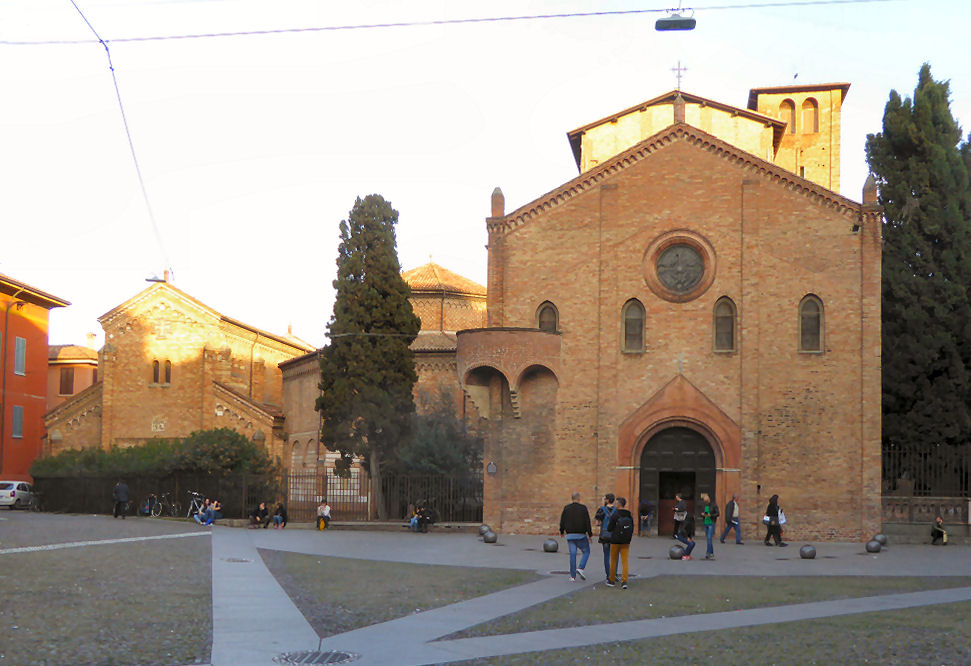
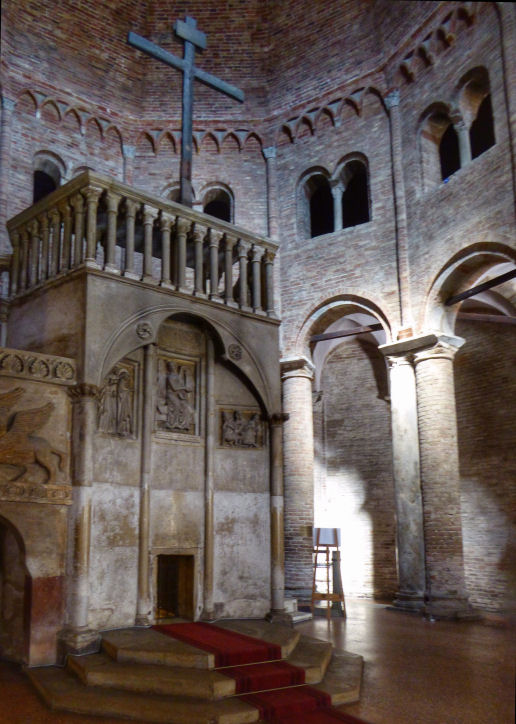

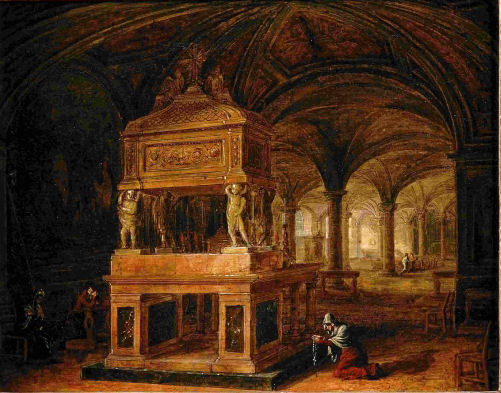
The church in art
The Tomb of the Saints Vitale and Agricola in the Underground
Church of Santo Stefano (see above)
from 1830 by Antonio Basoli.
Frescoes by Filippo Pedrini and Giuseppe Terzi in San Sepulcro,
removed
during the restoration of 1880 by
Giovanni Gozzadini and Raffaele Faccioli.
|

